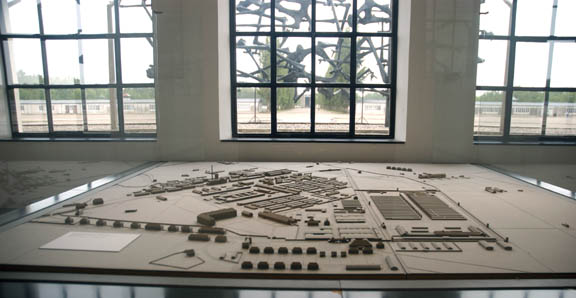The Museum at the Dachau Memorial Site  The museum displays that I saw at Dachau in May 2007 did not put as much emphasis on the events in Germany which led up to the takeover by the Nazis, as did the old museum which was first put up in 1965. This aspect of the Dachau story is put into perspective and is not given any more space than any other part of the history of the camp. The visitor is no longer given the impression that the museum is making excuses for the rise of the Nazis. The photograph above shows a display about the early years of Hitler and National Socialism in Germany. The new exhibits in the Dachau museum are drastically different from the old ones that I first saw in May 1997. On my first visit, I did not learn that Dachau was turned into a prison camp for Nazi war criminals after the war, nor that the camp was occupied by German refugees from 1948 until 1965; nor did I learn that the American Military Tribunals, in which the staff members of several concentration camps were put on trial, were held at Dachau. There was nothing in the old museum exhibits about the German criminals in the camp, and nothing about the former Commandants of the camp. All that has now changed. The photographs above show the new displays near the entrance to the museum. The display boards look as though they have just been carried into the building and are waiting to be mounted on the walls; the boards appear to be in danger of falling over at any moment, but this is actually part of the artistic concept of the museum. Near the entrance is a display which gives a brief chronological history of Dachau: the concentration camp opened on March 22, 1933. In 1934, 21 men were executed in Dachau in the Röhm Putsch. In 1937 construction work began on the erection of the new camp on the grounds of the old munitions factory at Dachau. The prisoners had previously been housed in the old factory buildings. In 1938, there were 11,000 German and Austrian Jews brought to Dachau in November, according to the display. However, it is not mentioned that this was the day after Kristallnacht nor that most of these new prisoners were quickly released after they promised to leave Germany within six months. According to the time-line shown in the museum, Gypsies were first brought to Dachau in 1939, and in 1940, there were 13,000 Polish prisoners brought to Dachau. In 1942, there were 2,500 Dachau prisoners sent to Hartheim Castle, and also in 1942, medical experiments were started at Dachau. In 1943, there were more than 150 sub-camps of Dachau set up. In 1944, there were 10,000 Jews "killed through work" in the sub-camps, according to the museum display. By the end of 1944, there were 63,000 prisoners in all the sub-camps; this was the year that a typhus epidemic started. I don't think the old exhibits in the museum even mentioned the word typhus.  The photo above shows a model of the Dachau camp which is on display at the museum. Through the windows, you can see the sculpture of the International Monument. The prison enclosure was only a small part of the Dachau complex, which included an SS army garrison, an SS training camp and factories where the prisoners worked. On the model, the actual concentration camp is the rectangle that is shown on the far right. ContinuePreviousHomeThis page was last updated on April 5, 2008 |